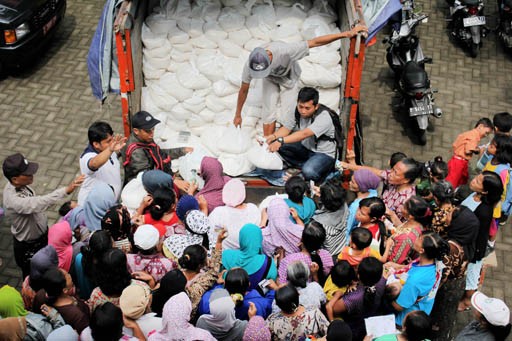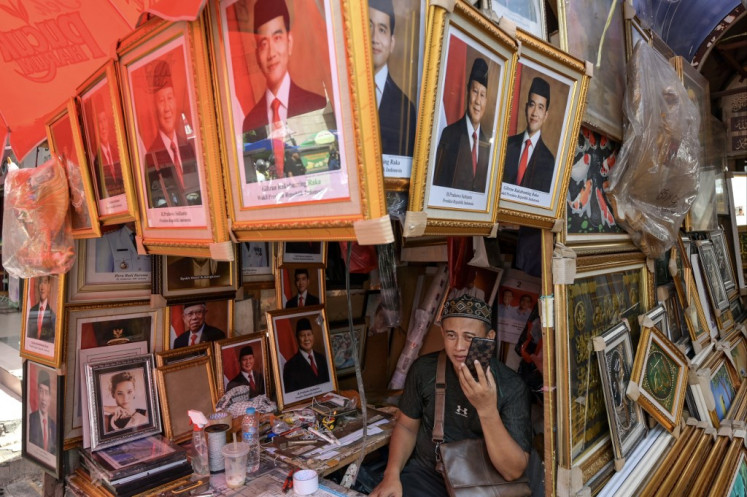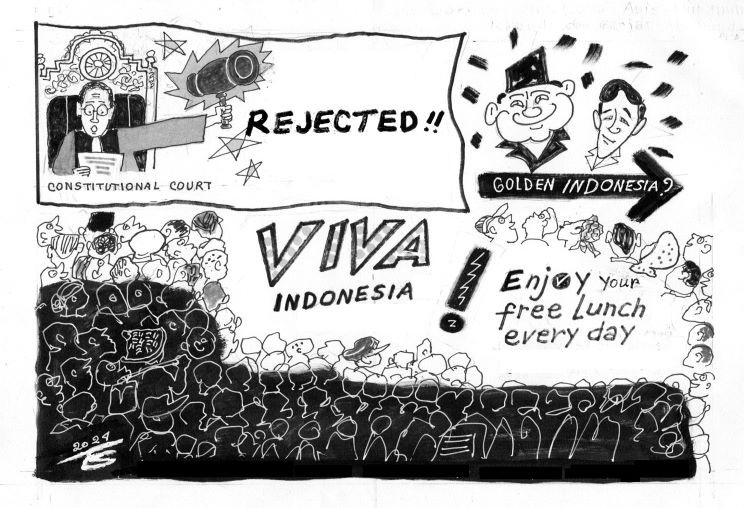Food inflation and the central bank's dilemma
In Indonesia, the share of food expenditure in total household expenditure is much higher than those in advanced countries.
Change Size
 People purchase rice during a market intervention in Bulak Banteng subdistrict, Surabaya, East Java, in a March 10 2015 file photo. The State Logistics Agency (Bulog) organized the event. (Antara/Bima)
People purchase rice during a market intervention in Bulak Banteng subdistrict, Surabaya, East Java, in a March 10 2015 file photo. The State Logistics Agency (Bulog) organized the event. (Antara/Bima)
E
conomic textbooks generally suggest that there are at least three main causes of inflation: demand-pull, cost-push and monetary expansion.
Demand-pull inflation is the most common. It is simply when demand for a good or service increases so much that it exceeds supply. A growing economy is an example of demand-pull inflation as people feel confident about the future and spend more.
The second cause of inflation is cost-push, which occurs when there is a shortage of supply combined with constant or enough demand. A common example of this is food price inflation, where the prices of food increase because of the rise of fertilizers’ price or supply shocks like crop failure. The third cause is an expansion of the money supply. When interest rate is low, loans are cheap, then there will be too much money chasing too few goods, creating inflation.
Economic textbooks also describe how central banks control inflation. One popular method of controlling inflation is through contractionary monetary policy; reduce money supply within an economy by increasing interest rates. This method is mainly used to address inflation that is caused by demand-pull and monetary expansion.
This helps reduce spending because when the interest rate is high, those who have money want to keep it and save it, instead of spending it. Because there is less money to go around, this also means less available credit, which also reduces spending.
While central banks can use the interest rate instrument to control inflation caused by demand-pull and monetary expansion, then what is the role of central banks in combating cost-push or food inflation?
This question has engaged economists for years. Like many other classic discussions on economic issues, the opinion on this has spanned the entire spectrum. At one end is the view that monetary policy should be the “first line of defense” no matter what the drivers of inflation.
At the other end is the view that the monetary policy is an inappropriate instrument to address supply pressures, and that the central bank should adopt a “hands off” approach. In the real world, however, it is much more complex than such binary prescriptions; management of food inflation has always been a complex challenge for the central bank, both by way of policy action and its communication.
Having said that, can the central bank simply ignore food inflation? In Indonesia, the share of food expenditure in total household expenditure is much higher than those in advanced countries. Correspondingly, the weight on food in the consumer price index (CPI) basket is also high.
According to the Central Statistics Agency’s (BPS) September data, the weight on food stuffs, processed foods, beverages and tobacco reached 42.7 percent in the CPI basket. Therefore, like in other emerging countries, food price shocks play a non-trivial role in inflation dynamics in Indonesia. Moreover, food price shocks in emerging countries like Indonesia are more volatile and persistent, and are propagated strongly into nonfood inflation and thus tend to have stronger and long-lasting effects on inflation (IMF, 2011a; Walsh, 2011).
Accordingly, ignoring commodity-price inflation in economies where food represent a large share of household expenditure may not be appropriate (Catão and Chang, 2010; Walsh, 2011). Anand and Prasad ( 2010 ) also conclude that a narrow policy focus on nonfood inflation can lead to suboptimal outcomes. In sum, ignoring food inflation in monetary policy formulation may lead to policy mistakes.
Then how should the central bank respond to food inflation? Generally speaking, high food prices often result from adverse supply shocks or large increases in input costs.
Thus, the question on the action of the central bank in responding to food inflation caused by a supply shock often gets more delicate because it involves the growth inflation trade-off.
In the event of a negative-supply shock, such as lower farm output resulting from a monsoon season, output may come down and the economy grows slower. If the central bank raises the interest rate, inflation may decelerate. However, it comes with the price of lower economic growth, since the money supply is decreasing and bank lending is costly. Thus, in the case of a negative supply shock, monetary policy confronts the dilemma of stabilizing output versus containing inflation.
So, the main challenge for the central bank is to determine if the supply shock is temporary or permanent. The conventional wisdom is that if the shock is temporary and inflation expectations are well anchored, i.e. people believe that the shock will not affect general prices in the future, monetary policy need not react to that supply shock.
If it is permanent or structural, where the change in relative prices caused by it results in higher general inflation, in the first round by the higher input costs, and in the second round through the impact on inflation expectation and wage bargaining, then monetary policy should react to the shock.
In other words, when supply shocks impact the trend of inflation, monetary policy should respond. In case of the former, monetary accommodation prevents further disruption to the growth momentum. In the latter case, however, an anti-inflationary monetary response may involve some sacrifice of growth.
Then, is there any other way out for central banks from this dilemma? A single leaf working alone provides no shade. In order to reduce the burden of adjustment on monetary policy, the central bank may use the hands of government to progress the structural reforms aimed to raise potential growth, in particular agricultural productivity.
Last but not least, coordination problems are the main issue in controlling inflation in developing countries with a decentralized system like Indonesia. Thus, collective institutional coordination and cooperation with the establishment of something like Indonesia’s Regional Inflation Task Force (TPID) is also critical to improve distribution channels and build efficient supply chain management.
***
The writer is an economic analyst at Bank Indonesia. The views expressed are his own.
---------------
We are looking for information, opinions, and in-depth analysis from experts or scholars in a variety of fields. We choose articles based on facts or opinions about general news, as well as quality analysis and commentary about Indonesia or international events. Send your piece to community@jakpost.com.








